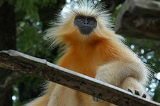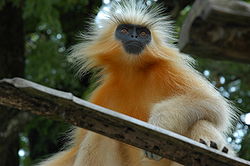
Gee's Golden Langur
Encyclopedia
Gee's golden langur or simply the golden langur, is an Old World monkey
found in a small region of western Assam
, India
and in the neighboring foothills of the Black Mountains
of Bhutan
. It is one of the most endangered primate species of India. Long considered sacred by many Himalayan people, the Golden Langur was first brought to the attention of science by the naturalist E. P. Gee
in the 1950s.In a part of Bhutan, it has hybridised with the Capped Langur T. pileatus.
. Its diet is herbivorous, consisting of ripe and unripe fruit
s, mature and young leaves, seeds, buds and flower
s.
 The regions of its distribution are very small; the main region is limited to an area approximately 60 miles square bounded on the south by the Brahmaputra river
The regions of its distribution are very small; the main region is limited to an area approximately 60 miles square bounded on the south by the Brahmaputra river
, on the east by the Manas river
, on the west by the Sankosh river, all in Assam
, India
, and on the north by the Black Mountains
of Bhutan
. These biogeographical barriers are believed to have led to the radiation of species from the closely related Capped Langur
(Trachypithecus pileatus). The best range maps so far are Choudhury (2002) and Choudhury (2008)
Gee's golden langur is currently endangered; a total Indian population in 2001 of 1,064 individuals, in 130 groups, was recorded. Of these, approximately 60% were adults indicating a relative lack of infants and juveniles. The relative dearth of infants and juveniles indicate a declining population and with the habitat being degraded by human activity. A fragmented but protected population in a rubber plantation in Nayakgaon, Kokrajhar district of Assam increased in population from 38 individuals in 1997 to 52 in 2002. The population has also adapted to feeding on dry rubber seeds.
The smallest golden langur troop was composed of four individuals, while the largest had 22, giving an average value of 8.2 individuals per troop. The adult gender ratio was 2.3 females to every male, although the majority of groups had only one adult male.
, India. As of 2000, one of these groups, consisting of six (and possibly eight) individuals in the Sepahijala Wildlife Sanctuary, had survived.
:
Old World monkey
The Old World monkeys or Cercopithecidae are a group of primates, falling in the superfamily Cercopithecoidea in the clade Catarrhini. The Old World monkeys are native to Africa and Asia today, inhabiting a range of environments from tropical rain forest to savanna, shrubland and mountainous...
found in a small region of western Assam
Assam
Assam , also, rarely, Assam Valley and formerly the Assam Province , is a northeastern state of India and is one of the most culturally and geographically distinct regions of the country...
, India
India
India , officially the Republic of India , is a country in South Asia. It is the seventh-largest country by geographical area, the second-most populous country with over 1.2 billion people, and the most populous democracy in the world...
and in the neighboring foothills of the Black Mountains
Black Mountains (Bhutan)
The Black Mountains is a mountain range located in Bhutan. The current Jigme Singye Wangchuck National Park was previously the Black Mountains park. Elevations run up to 15145 ft or 4617 meters. -References:...
of Bhutan
Bhutan
Bhutan , officially the Kingdom of Bhutan, is a landlocked state in South Asia, located at the eastern end of the Himalayas and bordered to the south, east and west by the Republic of India and to the north by the People's Republic of China...
. It is one of the most endangered primate species of India. Long considered sacred by many Himalayan people, the Golden Langur was first brought to the attention of science by the naturalist E. P. Gee
Edward Pritchard Gee
Edward Pritchard Gee was a Cambridge educated, Anglo-Indian tea-planter and an amateur naturalist in Assam, India. He is credited with the 1953 discovery of Gee's Golden Langur...
in the 1950s.In a part of Bhutan, it has hybridised with the Capped Langur T. pileatus.
Description
Golden langur is known for its rich golden to bright creamish hair, a black face and a very long tail measuring up to 50 centimetres (19.7 in) in length. For the most part, the langur is confined to high trees where its long tail serves as a balancer when it leaps across branches. During the rainy season it obtains water from dew and rain drenched leavesLeaf
A leaf is an organ of a vascular plant, as defined in botanical terms, and in particular in plant morphology. Foliage is a mass noun that refers to leaves as a feature of plants....
. Its diet is herbivorous, consisting of ripe and unripe fruit
Fruit
In broad terms, a fruit is a structure of a plant that contains its seeds.The term has different meanings dependent on context. In non-technical usage, such as food preparation, fruit normally means the fleshy seed-associated structures of certain plants that are sweet and edible in the raw state,...
s, mature and young leaves, seeds, buds and flower
Flower
A flower, sometimes known as a bloom or blossom, is the reproductive structure found in flowering plants . The biological function of a flower is to effect reproduction, usually by providing a mechanism for the union of sperm with eggs...
s.
Distribution

Brahmaputra River
The Brahmaputra , also called Tsangpo-Brahmaputra, is a trans-boundary river and one of the major rivers of Asia. It is the only Indian river that is attributed the masculine gender and thus referred to as a in Indo-Aryan languages and languages with Indo-Aryan influence...
, on the east by the Manas river
Manas River
The Manas River is a transboundary river in the Himalayan foothills between southern Bhutan and India.It is named after Manasa, the serpent god in Hindu mythology.It is the largest river system of Bhutan, among its four major river systems; the other three are Amo Chu or Torsa, Wong Chu or Raidak,...
, on the west by the Sankosh river, all in Assam
Assam
Assam , also, rarely, Assam Valley and formerly the Assam Province , is a northeastern state of India and is one of the most culturally and geographically distinct regions of the country...
, India
India
India , officially the Republic of India , is a country in South Asia. It is the seventh-largest country by geographical area, the second-most populous country with over 1.2 billion people, and the most populous democracy in the world...
, and on the north by the Black Mountains
Black Mountains (Bhutan)
The Black Mountains is a mountain range located in Bhutan. The current Jigme Singye Wangchuck National Park was previously the Black Mountains park. Elevations run up to 15145 ft or 4617 meters. -References:...
of Bhutan
Bhutan
Bhutan , officially the Kingdom of Bhutan, is a landlocked state in South Asia, located at the eastern end of the Himalayas and bordered to the south, east and west by the Republic of India and to the north by the People's Republic of China...
. These biogeographical barriers are believed to have led to the radiation of species from the closely related Capped Langur
Capped Langur
The capped langur is a species of primate in the Cercopithecidae family. It is found in Bangladesh, Nepal, Bhutan, China, India, and Myanmar. Its natural habitat is subtropical or tropical dry forests...
(Trachypithecus pileatus). The best range maps so far are Choudhury (2002) and Choudhury (2008)
Gee's golden langur is currently endangered; a total Indian population in 2001 of 1,064 individuals, in 130 groups, was recorded. Of these, approximately 60% were adults indicating a relative lack of infants and juveniles. The relative dearth of infants and juveniles indicate a declining population and with the habitat being degraded by human activity. A fragmented but protected population in a rubber plantation in Nayakgaon, Kokrajhar district of Assam increased in population from 38 individuals in 1997 to 52 in 2002. The population has also adapted to feeding on dry rubber seeds.
The smallest golden langur troop was composed of four individuals, while the largest had 22, giving an average value of 8.2 individuals per troop. The adult gender ratio was 2.3 females to every male, although the majority of groups had only one adult male.
Behavior
It generally lives in troops of about 8 (but sometimes up to 50) with several females to each adult male.Conservation
In 1988, two captive groups of golden langurs were released into two protected areas of the western region of the state of TripuraTripura
Tripura is a state in North-East India, with an area of . It is the third smallest state of India, according to area. Tripura is surrounded by Bangladesh on the north, south, and west. The Indian states of Assam and Mizoram lie to the east. The capital is Agartala and the main languages spoken are...
, India. As of 2000, one of these groups, consisting of six (and possibly eight) individuals in the Sepahijala Wildlife Sanctuary, had survived.
Taxonomy
There are believed to be two subspecies of this lutungLutung
The lutungs are a group of Old World monkeys and make up the entirety of the genus Trachypithecus. Their range is split into two parts; one part is much of southeast Asia , the other part is extreme southern India and Sri Lanka. The greater part of India has lutungs...
:
- Trachypithecus geei geei
- Trachypithecus geei bhutanensis

